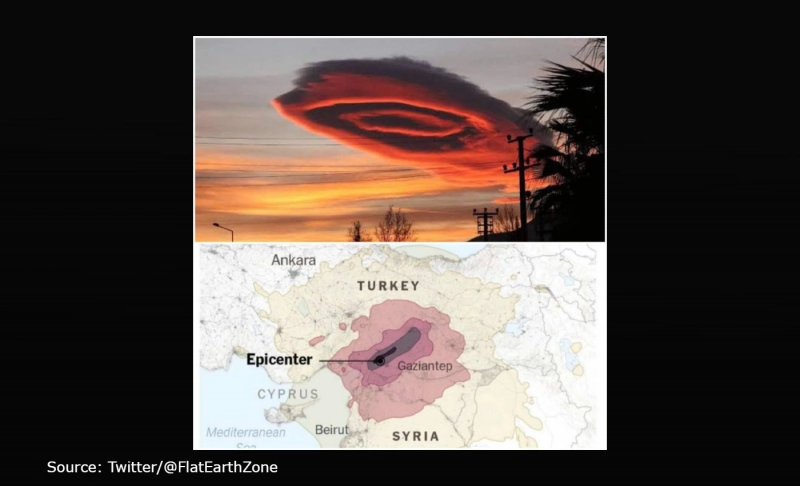By: Annie Priya
February 23 2023
False: The cloud that appeared over Turkey was prophetic as it resembled a map of the area affected by the recent 2023 earthquake.

The Verdict False
The cloud that appeared in Turkey before the earthquake is a natural phenomenon that is unrelated.
Context
In January 2023, an unusual cloud was observed and widely photographed over Bursa, Turkey. Social media users have since shared the image of this cloud along with a map of the area affected by the earthquake in Turkey, claiming the similarity in the shapes of the two means the cloud was a premonition of the devastating earthquakes that hit the region in February 2023.
One Facebook user wrote, "18 days before the earthquakes, the right-hand photo shows a strange cloud that showed up over Turkey. The map on the left shows the area of the greatest destruction in Turkey. Prophetic?" On Twitter, user @FlatEarthZone tweeted the two images to their 47,000-plus followers with the caption, "Do you remember a few days before the earthquake in Turkey, a strange cloud appeared in the sky? Look at this cloud, and the epicenter of the earthquake," attracting more than 7,500 likes and 2,500 retweets. However, this cloud has no link to the Turkey-Syria earthquake.
In Fact
On January 22, 2023, the Washington Post reported on the strange cloud formation over Bursa, noting that the orange-tinted cloud is known as a "lenticular cloud," which is common in the vicinity of tall mountains. It added that a similar cloud formation was spotted over Mount Shasta in Northern California in February 2020, a not-uncommon event as moisture from the Pacific Ocean is forced over the high terrain of nearby mountains.
According to the U.K.'s national weather service, the Met Office, "lenticular clouds form when the air is stable, and winds blow across hills and mountains from the same or similar direction at different heights through the troposphere [...] these lenticular clouds are a visible sign of mountain waves in the air. However, these waves can exist beyond the clouds even when no clouds are formed."
The image of the map which was shared in the posts was originally published by the New York Times on February 6, 2023, to explain the fault line caused by the initial quake and aftershock.
Additionally, the cloud was spotted over Bursa, northwest Turkey, near the Marmara Sea, but the epicenter of the February 6 earthquake was much further away from where the cloud was seen, in Gaziantep, near the Syrian border. Logically reached out to Mark William Wysocki, a professor in the Earth Science department at Cornell University, who stated there is no link between the two events in question.
Explaining the shape of the map in question, he said, "Since the earthquake and aftershocks are along a fault line and radiate outward, then yes, impacted areas will generally show an elliptical pattern. The final shape of the impact pattern is determined by the length/shape of the fault line and the underlying rock formation, so most are elliptical, with some showing a circular pattern. Again, there is no link between the two." The U.S. Geological Survey (USGS) also stated that "earthquakes have nothing to do with clouds."
The Verdict
There is no evidence that the cloud over Bursa had any connection to the Turkey earthquakes. Therefore, we have marked this claim as false.


